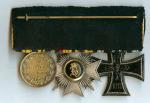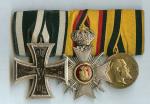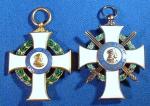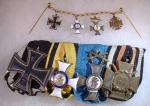
Beau Newman
Valued Member-
Posts
741 -
Joined
-
Last visited
-
Days Won
1
Content Type
Profiles
Forums
Blogs
Gallery
Events
Store
Everything posted by Beau Newman
-
The size of the crown doesn't really concern me. It is identical to the examples in Nimmergut. There is a bit of roughness at the sides of the crown where the hinged attachment points were finished off but, no worse than on most other pieces I have seen with articulated crowns. The overall workmanship and construction of the piece is nearly identical to the other Reuss crosses I have seen. My primary question with this group is the odd combination. I believe the pendants are OK but, I'm not convinced that the mounting is original.
-
I recently got this group. All the pieces look good. The mounting shows no sign of being played with and shows good age. It just seems to be a rather unusual combination, especially in the absence of other awards. Unfortunately, Reuss records are nearly nonexistent. I know the Reuss 3rd Class w/crown and swords was considered a Captain grade award while the Wurtt. Gold Medal was awarded to junior officers and very senior NCOs. Any thoughts?
-
I've had this Zahringen group for a while. The Oldenburg and Lubeck awards are common in Navy groups. He was obviously an old timer, with the 1897 medal and the 25 yr. LS Cross. He must have had some connection to Baden but, no 1902 Jubilee. To top it off, the bar has a Stuttgart maker's label. But, with no Wurttemberg awards, this was likely his home later in life when he was a Civil Servant. Does this combination point to a particular branch or unit?
-
The MSH Medals have always interested me. The Golden Medals are almost never seen. It makes me wonder how many of the actual gold examples ended up in the melting pot during the inflation of the 1920's. The Silver Medal has never received the respect I think it is due by the collecting community. While not rare, it is certainly a scarce award that represents a significant achievement by the original recipient.










